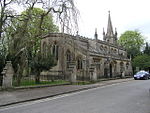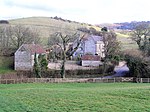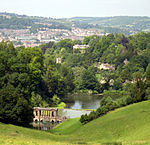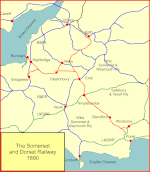Combe Down Tunnel
Buildings and structures in Bath, SomersetCombe DownFootpaths in SomersetHistory of Bath, SomersetRail trail tunnels in England ... and 6 more
Rail transport in SomersetSomerset and Dorset Joint RailwayTransport in Bath, SomersetTunnels completed in 1874Tunnels in SomersetUse British English from March 2018

Combe Down Tunnel is on the now-closed Somerset and Dorset Joint Railway main line, between Midford and Bath Green Park railway station, below high ground and the southern suburbs of Bath, England, emerging below the southern slopes of Combe Down village. Opened in 1874, this 1,829-yard (1,672 m) long disused railway tunnel was once the UK's longest without intermediate ventilation. The tunnel now forms part of the £1.8 million Two Tunnels Greenway walking and cycling path opened on 6 April 2013 and is the longest cycling tunnel in Britain. Its custodian is Wessex Water.
Excerpt from the Wikipedia article Combe Down Tunnel (License: CC BY-SA 3.0, Authors, Images).Combe Down Tunnel
Combe Down Tunnel, Bath Combe Down
Geographical coordinates (GPS) Address External links Nearby Places Show on map
Geographical coordinates (GPS)
| Latitude | Longitude |
|---|---|
| N 51.356 ° | E -2.3415 ° |
Address
Combe Down Tunnel
Combe Down Tunnel
BA2 5FW Bath, Combe Down
England, United Kingdom
Open on Google Maps










